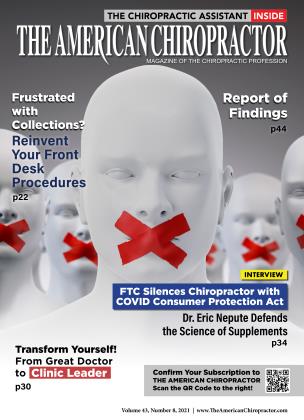Unlimited Flow of New Personal Injury Patients
August 1 2021 William Owens Jr., DC, DAAMLP, CPCUnlimited Flow of New Personal Injury Patients
August 1 2021 William Owens Jr., DC, DAAMLP, CPCAustin-McClellan and Lisi (2021) wrote, “Integration and closer collaboration with medicine has been a long-standing goal for the U.S. chiropractic profession. A futurist analysis has recommended that the chiropractic profession increase its integration within mainstream medicine in the coming years. According to the report, chiropractors will be integrated and exposed to allopathic physicians with increasing frequency through student clerkships, residencies, and chiropractic government programs, such as the Loan Repayment Program of the National Health Service Corps.” (p. 72) Many doctors of chiropractic are already seeing this play out in communities across the country. One of the many benefits of this type of exposure is that medical providers are learning chiropractic’s place in the diagnosis and management of spine pain. The result is a process of conservative management of the spine pain patient, with doctors of chiropractic being the “spine management physician” between the medical and legal professions in a patient-centered model. The paper continued, “Interprofessional collaboration has been known to improve healthcare processes and outcomes and has been acknowledged by the World Health Organization to be necessary to the success of primary health care.” (p. 72) The authors reported, “A barrier to collaboration and chiropractic integration in medical settings may be the lack of interprofessional education.” (p. 72) The misconception may be how advanced levels of training can be organized and delivered to increase interprofessional collaboration and communication. Based on the past and current models, it appears that this type of exposure to each other as professionals is best served at the graduate level in both medicine and chiropractic. That means the academic expansion of advanced training in both chiropractic and medicine is necessary for the form of expanded residency, fellowship, and master’s degree training programs.
On a national level, we are already seeing this happen within continuing education programming and advanced fellowship training programs, such as the National Spine Management Group’s Fellowship in Spinal Biomechanics and Trauma. Ensuring that all targeted healthcare providers understand the duties of each other and communicate in a single common language is critical, particularly in the healthcare industry where time and resources are limited. The Chiropractic Residency Program at the Veterans Administration is another great example of the evolution of interprofessional spine care.
..."A baseline understanding of the specialties presented herein is an important underpinning for chiropractic practice."...
The authors continued by stating, “The purpose of this article is to identify an initial set of medical specialties most broadly related to typical U.S. chiropractic practice. Our aim is to describe those specialties that U.S. chiropractors are most likely to receive referrals from and/or send referrals to in the course of patient care, hoping that this material may assist in interprofessional education of chiropractors.” (p. 73) “This work describes eight medical and two surgical specialties proposed to be most relevant to general chiropractic practice in the United States.” (p. 77) The paper included the following professional medical boards as a starting point for collaboration: internal medicine, family medicine, physical medicine and rehabilitation, neurology, pain medicine, rheumatology, radiology, orthopedic surgery, and neurologic surgery. The authors concluded with, “A baseline understanding of the specialties presented herein is an important underpinning for chiropractic practice. Other medical specialties may be applicable to chiropractors who serve more of a niche patient population. This could include occupational medicine, sports medicine, obstetrics and gynecology, oncology, and pediatrics.” (p. 77)
Proper communication through understanding, efficient documentation sharing systems and clinical collaboration is the only visible road to improving global spine care outcomes. Properly trained doctors of chiropractic can be important facilitators in the process of patient-centered and evidence-based care. This is especially true when working with personal injury patients, who tend to have multiple injuries and a team of healthcare providers. How is your office communicating?
Dr. William Owens Jr. is currently in private practice in Buffalo, NY. His practice employs 4 Doctors of Chiropractic and 2 Physical Therapists. He is President and CEO of the National Spine Management Group, LLC and Clinical Director of the Fellowship in Spinal Biomechanics and Trauma. Additionally, Dr. Owens is Adjunct Faculty in Family Medicine at the State University of New York at Buffalo Jacobs School of Medicine. He can be reached at 716.228.3847.
Reference
1. Austin-McClellan, L. E., & Lisi, A. J. (2021). An overview of the medical specialties most relevant to chiropractic practice and education. Journal of Chiropractic Education, 35(1), 72-79.
 View Full Issue
View Full Issue






